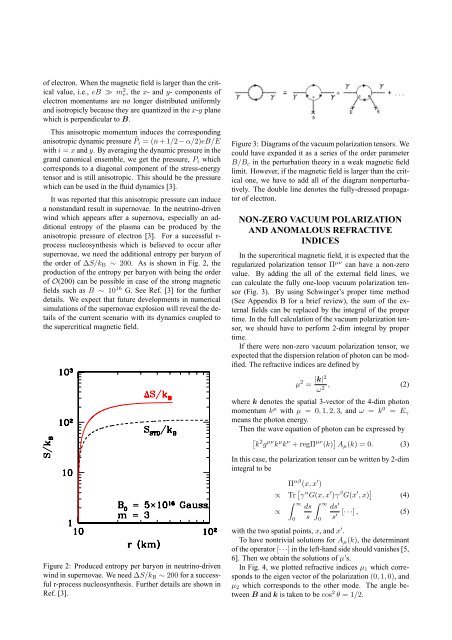Proceedings of International Conference on Physics in ... - KEK
Proceedings of International Conference on Physics in ... - KEK
Proceedings of International Conference on Physics in ... - KEK
Create successful ePaper yourself
Turn your PDF publications into a flip-book with our unique Google optimized e-Paper software.
<str<strong>on</strong>g>of</str<strong>on</strong>g> electr<strong>on</strong>. When the magnetic field is larger than the critical<br />
value, i.e., eB ≫ m 2 e, the x- and y- comp<strong>on</strong>ents <str<strong>on</strong>g>of</str<strong>on</strong>g><br />
electr<strong>on</strong> momentums are no l<strong>on</strong>ger distributed uniformly<br />
and isotropicly because they are quantized <strong>in</strong> the x-y plane<br />
which is perpendicular to B.<br />
This anisotropic momentum <strong>in</strong>duces the corresp<strong>on</strong>d<strong>in</strong>g<br />
anisotropic dynamic pressure ˜ Pi = (n + 1/2 − α/2)eB/E<br />
with i = x and y. By averag<strong>in</strong>g the dynamic pressure <strong>in</strong> the<br />
grand can<strong>on</strong>ical ensemble, we get the pressure, Pi which<br />
corresp<strong>on</strong>ds to a diag<strong>on</strong>al comp<strong>on</strong>ent <str<strong>on</strong>g>of</str<strong>on</strong>g> the stress-energy<br />
tensor and is still anisotropic. This should be the pressure<br />
which can be used <strong>in</strong> the fluid dynamics [3].<br />
It was reported that this anisotropic pressure can <strong>in</strong>duce<br />
a n<strong>on</strong>standard result <strong>in</strong> supernovae. In the neutr<strong>in</strong>o-driven<br />
w<strong>in</strong>d which appears after a supernova, especially an additi<strong>on</strong>al<br />
entropy <str<strong>on</strong>g>of</str<strong>on</strong>g> the plasma can be produced by the<br />
anisotropic pressure <str<strong>on</strong>g>of</str<strong>on</strong>g> electr<strong>on</strong> [3]. For a successful rprocess<br />
nucleosynthesis which is believed to occur after<br />
supernovae, we need the additi<strong>on</strong>al entropy per bary<strong>on</strong> <str<strong>on</strong>g>of</str<strong>on</strong>g><br />
the order <str<strong>on</strong>g>of</str<strong>on</strong>g> ∆S/kB ∼ 200. As is shown <strong>in</strong> Fig. 2, the<br />
producti<strong>on</strong> <str<strong>on</strong>g>of</str<strong>on</strong>g> the entropy per bary<strong>on</strong> with be<strong>in</strong>g the order<br />
<str<strong>on</strong>g>of</str<strong>on</strong>g> O(200) can be possible <strong>in</strong> case <str<strong>on</strong>g>of</str<strong>on</strong>g> the str<strong>on</strong>g magnetic<br />
fields such as B ∼ 10 16 G. See Ref. [3] for the further<br />
details. We expect that future developments <strong>in</strong> numerical<br />
simulati<strong>on</strong>s <str<strong>on</strong>g>of</str<strong>on</strong>g> the supernovae explosi<strong>on</strong> will reveal the details<br />
<str<strong>on</strong>g>of</str<strong>on</strong>g> the current scenario with its dynamics coupled to<br />
the supercritical magnetic field.<br />
Figure 2: Produced entropy per bary<strong>on</strong> <strong>in</strong> neutr<strong>in</strong>o-driven<br />
w<strong>in</strong>d <strong>in</strong> supernovae. We need ∆S/kB ∼ 200 for a successful<br />
r-process nucleosynthesis. Further details are shown <strong>in</strong><br />
Ref. [3].<br />
Figure 3: Diagrams <str<strong>on</strong>g>of</str<strong>on</strong>g> the vacuum polarizati<strong>on</strong> tensors. We<br />
could have expanded it as a series <str<strong>on</strong>g>of</str<strong>on</strong>g> the order parameter<br />
B/Bc <strong>in</strong> the perturbati<strong>on</strong> theory <strong>in</strong> a weak magnetic field<br />
limit. However, if the magnetic field is larger than the critical<br />
<strong>on</strong>e, we have to add all <str<strong>on</strong>g>of</str<strong>on</strong>g> the diagram n<strong>on</strong>perturbatively.<br />
The double l<strong>in</strong>e denotes the fully-dressed propagator<br />
<str<strong>on</strong>g>of</str<strong>on</strong>g> electr<strong>on</strong>.<br />
NON-ZERO VACUUM POLARIZATION<br />
AND ANOMALOUS REFRACTIVE<br />
INDICES<br />
In the supercritical magnetic field, it is expected that the<br />
regularized polarizati<strong>on</strong> tensor Π µν can have a n<strong>on</strong>-zero<br />
value. By add<strong>in</strong>g the all <str<strong>on</strong>g>of</str<strong>on</strong>g> the external field l<strong>in</strong>es, we<br />
can calculate the fully <strong>on</strong>e-loop vacuum polarizati<strong>on</strong> tensor<br />
(Fig. 3). By us<strong>in</strong>g Schw<strong>in</strong>ger’s proper time method<br />
(See Appendix B for a brief review), the sum <str<strong>on</strong>g>of</str<strong>on</strong>g> the external<br />
fields can be replaced by the <strong>in</strong>tegral <str<strong>on</strong>g>of</str<strong>on</strong>g> the proper<br />
time. In the full calculati<strong>on</strong> <str<strong>on</strong>g>of</str<strong>on</strong>g> the vacuum polarizati<strong>on</strong> tensor,<br />
we should have to perform 2-dim <strong>in</strong>tegral by proper<br />
time.<br />
If there were n<strong>on</strong>-zero vacuum polarizati<strong>on</strong> tensor, we<br />
expected that the dispersi<strong>on</strong> relati<strong>on</strong> <str<strong>on</strong>g>of</str<strong>on</strong>g> phot<strong>on</strong> can be modified.<br />
The refractive <strong>in</strong>dices are def<strong>in</strong>ed by<br />
µ 2 = |k|2<br />
, (2)<br />
ω2 where k denotes the spatial 3-vector <str<strong>on</strong>g>of</str<strong>on</strong>g> the 4-dim phot<strong>on</strong><br />
momentum k µ with µ = 0, 1, 2, 3, and ω = k 0 = Eγ<br />
means the phot<strong>on</strong> energy.<br />
Then the wave equati<strong>on</strong> <str<strong>on</strong>g>of</str<strong>on</strong>g> phot<strong>on</strong> can be expressed by<br />
[ k 2 g µν k µ k ν + regΠ µν (k) ] Aµ(k) = 0. (3)<br />
In this case, the polarizati<strong>on</strong> tensor can be written by 2-dim<br />
<strong>in</strong>tegral to be<br />
Π αβ (x, x ′ )<br />
∝ Tr [ γ α G(x, x ′ )γ β G(x ′ , x) ]<br />
∝<br />
∫ ∞<br />
0<br />
ds<br />
s<br />
∫ ∞<br />
0<br />
(4)<br />
ds ′<br />
s ′ [· · ·] , (5)<br />
with the two spatial po<strong>in</strong>ts, x, and x ′ .<br />
To have n<strong>on</strong>trivial soluti<strong>on</strong>s for Aµ(k), the determ<strong>in</strong>ant<br />
<str<strong>on</strong>g>of</str<strong>on</strong>g> the operator [· · ·] <strong>in</strong> the left-hand side should vanishes [5,<br />
6]. Then we obta<strong>in</strong> the soluti<strong>on</strong>s <str<strong>on</strong>g>of</str<strong>on</strong>g> µ’s.<br />
In Fig. 4, we plotted refractive <strong>in</strong>dices µ1 which corresp<strong>on</strong>ds<br />
to the eigen vector <str<strong>on</strong>g>of</str<strong>on</strong>g> the polarizati<strong>on</strong> (0, 1, 0), and<br />
µ2 which corresp<strong>on</strong>ds to the other mode. The angle between<br />
B and k is taken to be cos 2 θ = 1/2.













